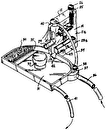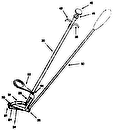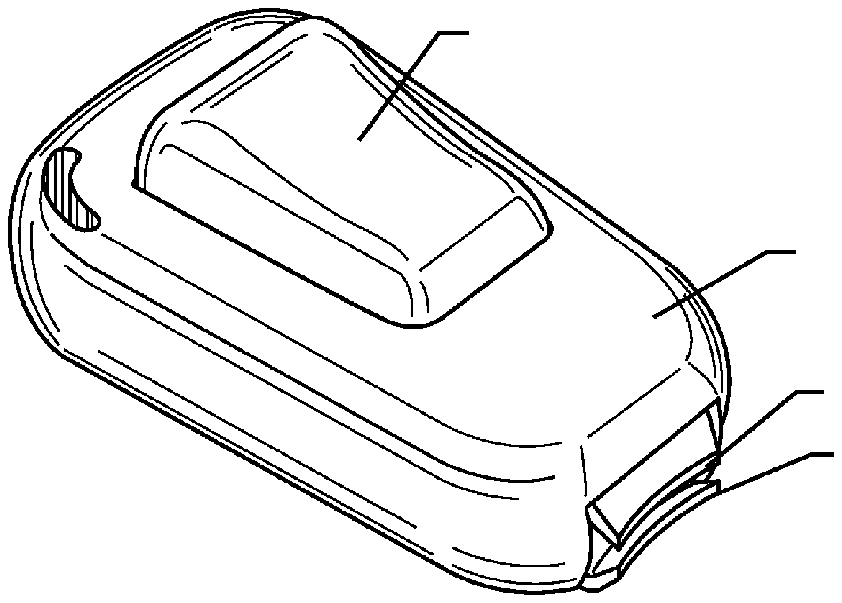
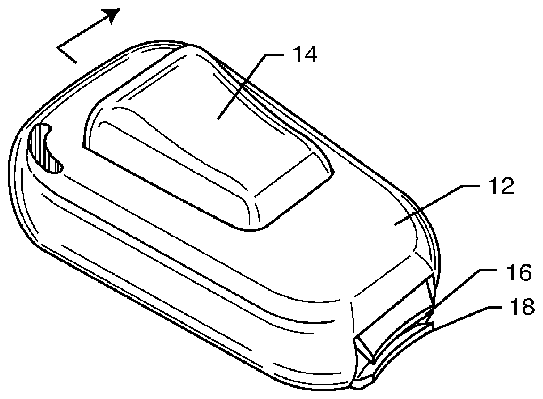
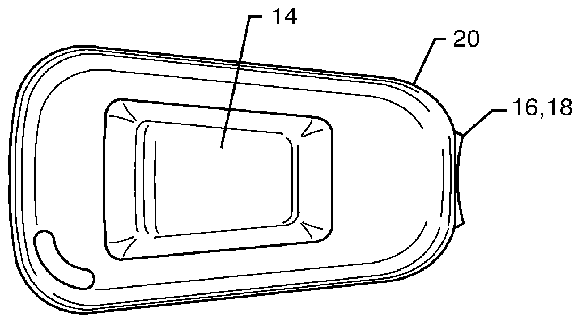
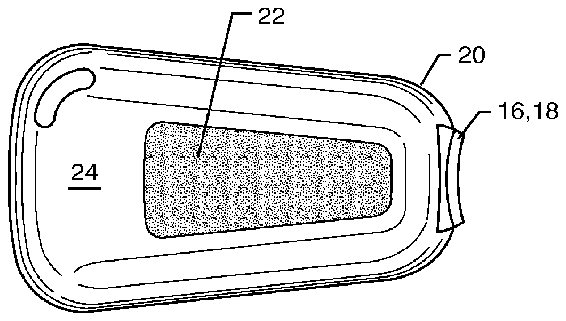
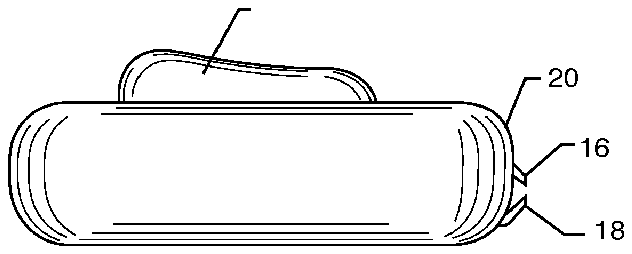
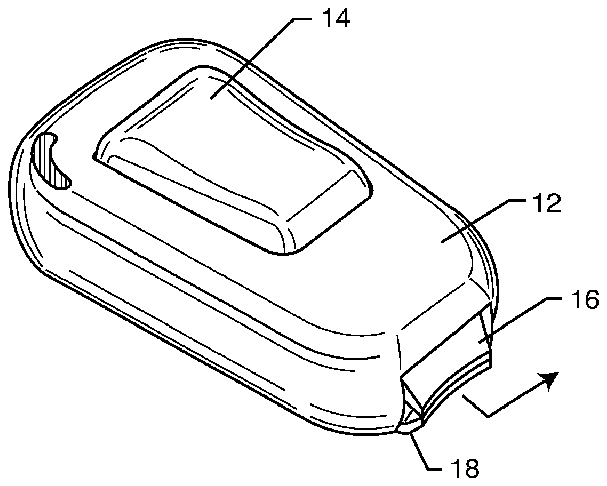
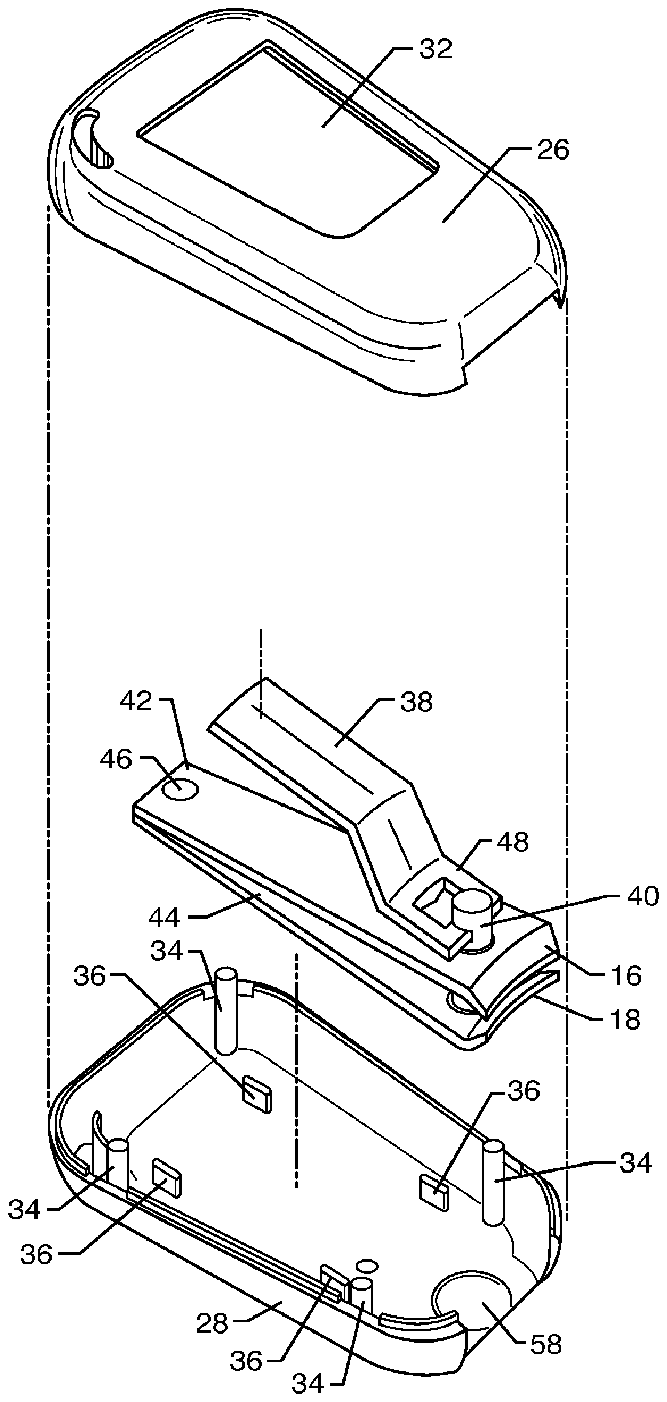
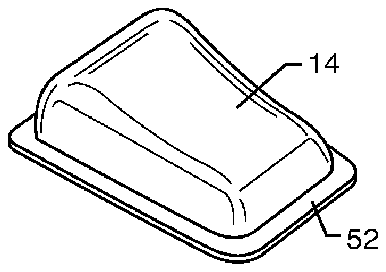
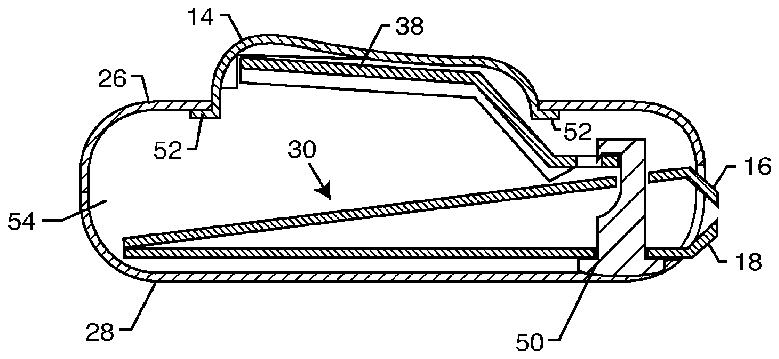
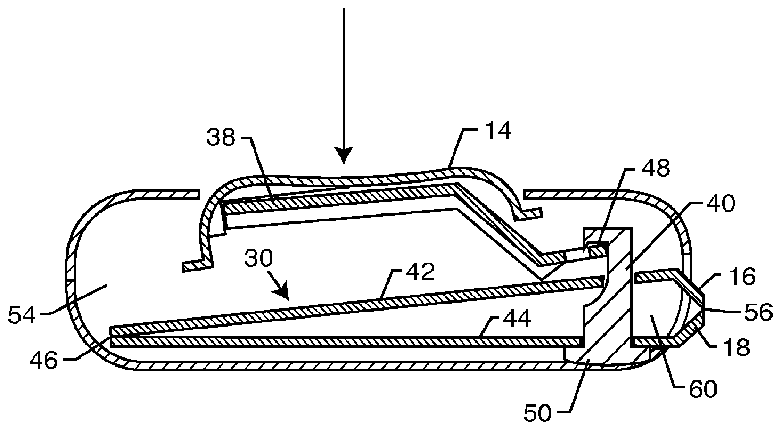
- 7line
- 8line
- 10nail clipper assembly
- 12outer housing
- 14button
- 16cutting edges
- 18cutting edge
- 20front surface
- 22file
- 24bottom side
- 26upper housing
- 28lower housing
- 30nail clippers
- 32aperture
- 34guide bars
- 36alignment posts
- 38lever
- 40fulcrum
- 42top plate
- 44bottom plate
- 46pivot
- 48engagement end
- 50lip
- 52periphery
- 54interior chamber
- 56contact point
- 58concave section
- 60chamber
Abstract
The nail clipper assembly includes a base having a pair of opposing nail clipping blades spring biased away from one another. A lever capable of actuating the clipping blades is rotationally attached to the base. A housing substantially enclosing the base and lever includes an aperture through which the clipping blades may at least partially extend. A manually actuable button coupled to the housing engages the lever to move the clipping blades toward one another so that a user may cut a nail with the nail clipper assembly.
Description
BACKGROUND OF THE INVENTION
[0001] The present invention relates to a nail clipper assembly. More particularly, the present invention relates to a nail clipper assembly that provides ergonomic activation of the nail cutters and stores nail clippings.
[0002] Nail clippers are generally well known in the art and are designed to remove or cut off portions of toenails and/or fingernails. Such nail clippers are typically compact and designed to be carried in a pocket or purse where it is readily available for later use. Some nail clippers include additional nail care tools such as a file that can manicure or round-out rough or jagged nail edges. Other nail clippers may include a tip extending or projecting from one end or a side of the nail clippers for use in cleaning dirt or debris out from underneath the nail. Yet other nail clippers may further include a clip for connecting the nail clipper to an item such as a key ring or may include an integral pocket knife.
[0003] Conventional nail clippers are usually made of a solid material such as metal or hard plastic. Such nail clippers typically include some form of a lever or handle that swings or pivots about a fulcrum and is used to activate a pair of cutting edges. The cutting edges themselves are almost always made out of a sharpened metal material and may be concave in shape to better fit the arc of the nail head. The cutting edges are disposed at one end of a pair of spring-biased arms or elongated bars secured together at a second, opposite end. The spring-biased arms/bars ensure that the cutting edges remain in an open position when the nail clipper is not being used. The cutting edges activate through pivotal depression of the lever about a fulcrum that extends through both spring-biased arms/bars and engages the underside of the lower arm/bar near the end having the cutting edges. The lever also rotationally couples to the fulcrum and may include some protrusion or “toe” that presses against the top spring-biased arm to drive the cutting edges into contact with one another when depressed. That is, the user depresses the lever toward the surface of the spring-biased arm, forces the fulcrum upward such that engagement with the lower spring-biased arm causes each spring-biased arm to move toward one another thereby bringing the cutting edges together in a clipping relationship.
[0004] The lever or handle may have a tendency to rotate left-to-right or right-to-left about the fulcrum during the cutting operation. This is particularly problematic because the lever or handle is generally elongated and fails to provide stability against such rotational movement. In turn, this may impede comfort, use of the nail clippers and the accuracy of cutting the nail. A single pivoting lateral lever may even require excessive and imprecise handle movement to perform the cutting operation. For example, the sharp edges of the nail clipper may inadvertently pinch, cut or nick the skin surrounding the fingernail or toenail of the person handling the nail clipper. This primarily occurs due to the misalignment of the nail clipper relative to the nail. Consequently, inadvertent movement of the lever or handle during the cutting operation may cause such misalignment. Poor lighting can also be particularly problematic as the user is unable to align the nail clippers in the proper position and depth to cut the nails without injury. Oftentimes, the nail clippers may extend too far up underneath the nail such that the user clips a portion of the skin where the nail contacts the nail bed. This can be particularly painful and may even cause bleeding. Additionally, the exposed cutting edges may damage clothing during transportation when placed in a pocket or purse. The cutting edges may also have a tendency to damage the interior of a drawer when placed therein for storage. Some prior art nail clippers include a selectively removable guard to protect the aforementioned items from damage. But, the guard itself may be easily lost or become dislodged from the nail clippers during transportation. When detached, the guard is an ineffective preventative measure against damage to surrounding objects or containers.
[0005] Conventional nail clippers also fail to retain fingernail or toenail clippings. This is particularly undesirable for purposes of maintaining the cleanliness of the area surrounding where the toenails or fingernails are cut. It is therefore preferable that conventional nail clippers include some means for containing nail clippings. Moreover, clippings tend to scatter or jump randomly away from the cutting edges during the cutting process. This is particularly problematic when a person endeavors to cut their fingernails, for example, in public. It is highly desirable to contain the clippings in order to prevent a mess from forming around the floor, surrounding furniture and other places nearby.
[0006] There exists, therefore, a significant need for a nail clipper that provides ergonomic and safe activation of the nail cutters and stores nail clippings. Such an improved nail clipper should include a compartment for storing one of a plurality of differently sized and/or shaped conventional nail clippers, should include an ergonomic pushbutton that activates the clipping mechanism, should include a compartment for storing nail clippings, and should be easy to manufacture and cost effective. The present invention fulfills these needs and provides further related advantages.
SUMMARY OF THE INVENTION
[0007] The nail clipper assembly includes a base having a pair of opposing nail clipping blades spring biased away from one another. A lever is rotationally attached to the base and used to actuate the clipping blades. The nail clipper assembly further includes a housing substantially enclosing the base and lever. The housing includes an aperture through which the clipping blades at least partially extend so a user may cut toenails or fingernails. A manually actuable button engages the lever to move the clipping blades toward one another to perform cutting. The housing generally forms into a compartment for retaining nail clippings. Additionally, the housing preferably includes a pair of sidewalls adjacent to opposite ends of the clipping blades. The sidewalls buffer the cutting depth of the clipping blades and may also cooperate with the base to retain the nail clippings within the compartment. The sidewalls are also preferably configured to prohibit angled cuts and contact of the clipping blades with skin surrounding the nail. This particular feature enhances the safety of the nail clipper assembly disclosed herein.
[0008] The button preferably couples to the lever to permit single plane movement thereof, thereby enhancing one-handed operational stability in view of levers that are otherwise freely rotationally attached to the base. The button preferably encompasses the lever and includes a surface area relatively larger than the surface area of the lever. The contour of the button complements the outer surface of the housing and is ergonomically contoured for one-handed operation. In one preferred embodiment, the nail clipper assembly includes a file disposed on the exterior of the housing. Such a file may include silicon carbide to ensure operational longevity.
[0009] Other features and advantages of the present invention will become apparent from the following more detailed description, when taken in conjunction with the accompanying drawings, which illustrate, by way of example, the principles of the invention.
BRIEF DESCRIPTION OF THE DRAWINGS
[0010] The accompanying drawings illustrate the invention. In such drawings:
[0011] FIG. 1 a perspective view of a nail clipper assembly as described herein;
[0012] FIG. 2 is a top view of the nail clipper assembly;
[0013] FIG. 3 is a bottom view of the nail clipper assembly;
[0014] FIG. 4 is a side view of the nail clipper assembly;
[0015] FIG. 5 is another perspective view of the nail clipper assembly, illustrating depression of the button and activation of the cutting edges;
[0016] FIG. 6 is an exploded perspective view of the nail clipper assembly housing conventional nail clippers;
[0017] FIG. 7 is a cross-sectional view of the nail clipper assembly of FIG. 1 , taken about the line 7 - 7 ; and
[0018] FIG. 8 is a cross-sectional view of the nail clipper assembly of FIG. 5 , taken about the line 8 - 8 .
DETAILED DESCRIPTION OF THE PREFERRED EMBODIMENTS
[0019] As shown in the drawings for purposes of illustration, the present invention for a nail clipper assembly is referred to generally by the reference number 10 . In FIG. 1 , the nail clipper assembly 10 is shown in its preferred form. The nail clipper assembly 10 generally includes an outer housing 12 having an integral ergonomic button 14 that activates conventional nail clippers stored within the interior of the outer housing 12 . In FIG. 1 , a pair of somewhat arcuate-shaped cutting edges 16 , 18 protrude out from within the interior of the outer housing 12 to enable a user to cut fingernails or toenails with the nail clipper assembly 10 . The cutting edges 16 , 18 are preferably arcuate to fit the contour of the nail head. But, the shape of the cutting edges 16 , 18 may vary depending on the desired application. The contoured shape of the outer housing 12 is designed to fit comfortably in the hands of a user and eliminate the need to use the clumsy handle or lever, as described above. A simple push of the button 14 cleanly and effectively activates the cutting edges 16 , 18 , as described in more detail below. The nail clipper assembly 10 is safe, hygienic and easy to use. Furthermore, it is ideal for use with active adults, safe for infants and children and easy to hold for the elderly. The width of the button 14 in particular provides a large surface area and a non-rotatable mechanism so the user may easily activate the clipping action associated with each of the cutting edges 16 , 18 .
[0020] As shown in FIGS. 2-3 , the cutting edges 16 , 18 extend out away from a front surface 20 of the nail clipper assembly 10 . The cutting edges 16 , 18 are strategically positioned such that a user may only cut off a portion of the fingernail or toenail in one cut. This significantly reduces the potential to over cut the nail. The positioning of the front surface 20 that encompasses the cutting edges 16 , 18 effectively prevents a user from inserting an undesirable depth of fingernail or toenail into the cutting edges 16 , 18 . It is the placement of the walls of the front surface 20 adjacent the cutting edges 16 , 18 that prevents the user from loping off too much nail at one time. In turn, this promotes healthy fingernail growth by the fact that the cutting edges 16 , 18 are able to more cleanly cut the subject nail. Of course, the tolerance between the front surface 20 of the outer housing 12 and the cutting edges 16 , 18 can vary. It is preferred that such a nail clipper assembly 10 be toleranced to effectively prevent a user from being able to extend portions of the finger into the cutting edges 16 , 18 . These features make the nail clipper assembly 10 particularly ideal for use with infants and other young children. The positioning of the cutting edges 16 , 18 and the front surface 20 prevents an extreme angle cut or an undesirable cut in the event of an abrupt move or unexpected slip of the conventional handle or lever, especially for use with a child. In particular, the relationship between the outer housing 12 and the cutting edges 16 , 18 prevents a user from clipping into the skin or clipping into the sides of the fingers as so often happens with the use of the aforementioned conventional nail clippers.
[0021] Also as shown in FIGS. 1-5 is the ergonomic design of the nail clipper assembly 10 and the button 14 . The button 14 is generally contoured and is designed to fit naturally to the shape of the thumb and hand of a user. This provides a comfortable grip and enables “one handed” operation. Relative to the aforementioned conventional nail clippers, the user does not have to worry about flipping or twisting any handles or levers with the opposite hand to work the nail clipper assembly 10 . Furthermore, the nail clipper assembly 10 is ergonomic in design. The outer housing 12 may also include a non-slip or textured surface that prevents the nail clipper assembly 10 from slipping out of the hand of the user. The angled position of the button 14 also requires less force to activate the cutting edges 16 , 18 , thereby enhancing the mechanical advantage of the nail clipper assembly 10 . The width and length of the button 14 also increases the surface area with which the user may activate the cutting edges 16 , 18 . The user will experience even depression of the cutting edges 16 , 18 no matter where on the button 14 pressure is applied. The shape of the button 14 lends to a natural and comfortable range of motion for the hand. The user is not required to maneuver the hand to an uncomfortable position as is necessary with convention fingernail clippers.
[0022] Furthermore, the nail clipper assembly 10 includes a file 22 as generally shown in FIG. 3 . The file 22 is preferably disposed on a bottom side 24 so as to ensure free and clear use relative to other components of the nail clipper assembly 10 , such as the button 14 or the cutting edges 16 , 18 . But, the file 22 may be located nearly anywhere along the surface of the outer housing 12 . The file 22 is preferably made from a silicon-carbide material capable of rounding out or grinding down sharp/jagged edges formed by cutting fingernails or toenails. The silicon-carbide composite ensures years of filing consistency without dulling. The file 22 may be disposed on the bottom side 24 in any one of a number of different shapes and/or sizes depending on the particular application with which the nail clipper assembly 10 is to be used. Preferably, the file 22 is of an area large enough so that a user may easily file fingernails and/or toenails.
[0023] FIG. 6 illustrates an exploded perspective view of the nail clipper assembly 10 as disclosed herein. In one embodiment, the outer housing 12 comprises an upper housing 26 and a lower housing 28 that couple together to encase the button 14 and a conventional nail clipper 30 . The upper housing 26 includes an aperture 32 through which the button 14 may protrude for fingertip access by the user. The lower housing 28 includes a plurality of guide bars 34 that selectively slidingly engage a plurality of detents (not shown) in the upper housing 26 . The guide bars 34 ensure alignment of the upper housing 26 with the lower housing 28 during assembly. The upper housing 26 and the lower housing 28 may be permanently or selectively detachably connected thereto to form the aforementioned outer housing 12 of the nail clipper assembly 10 . For example, the upper housing 26 may snap, clip, lock or otherwise adhesively secure to the lower housing 28 . Permanent securement of the upper housing 26 to the lower housing 28 ensures that the cavity formed therein cannot be inadvertently accessed by the user. This is particularly preferred as the housing may be used to retain nail clippings, as described in more detail below. The lower housing 28 also includes a set of alignment posts 36 that position the nail clippers 30 within the interior of the outer housing 12 . This ensures the stability of the nail clippers 30 within the interior of the outer housing 12 when biased therein between the button 14 and the lower housing 28 .
[0024] The nail clippers 30 include a handle or lever 38 rotationally connected to a fulcrum 40 that extends through a top plate 42 having the cutting edge 16 and a bottom plate 44 having the cutting edge 18 . The top plate 42 is spring-biased relative to the bottom plate 44 about a pivot 46 opposite the cutting edges 16 , 18 . The pivot 46 positions the cutting edges 16 , 18 in an open position as generally shown in FIG. 6 during non-use. An engagement end 48 of the lever 38 coupled to the fulcrum 40 enables a user to close the gap between the cutting edges 16 , 18 by depressing the lever 38 toward the top plate 42 . The fulcrum 40 actually extends all the way through the width of the bottom plate 44 and has a lip 50 that engages the surface underneath the bottom plate 44 . In turn, the engagement end 48 endeavors to pull the fulcrum 40 out from within each of the plates 42 , 44 . But, the lip 50 of the fulcrum 40 , as engaged to the underside of the bottom plate 44 , causes compression of the spring-biased plates 42 , 44 about the pivot 46 such that the cutting edge 16 engages the cutting edge 18 . Release of the lever 38 causes the spring-biased plates 42 , 44 to return to a resting position wherein the cutting edges 16 , 18 are separated from one another. As shown with respect to FIGS. 7 and 8 below, the button 14 is capable of actuating the lever 38 in the manner previously described.
[0025] FIG. 7 is a cross-sectional view of the nail clipper assembly 10 wherein the cutting edges 16 , 18 are disengaged from one another. As shown, the button 14 includes a flat outer periphery 52 (shown best in FIG. 6 ) that engages a portion of the upper housing 26 . The lever 38 of the nail clipper 30 biases the button 14 out from within an interior chamber 54 formed by the upper housing 26 and the lower housing 28 . The lever 38 ensures that the periphery 52 remains engaged with the upper housing 26 such that the cutting edges 16 , 18 allow a user to insert a fingernail therebetween to be cut. Depression of the button 14 along the directional arrow shown in FIG. 8 causes the lever 38 to depress into the interior chamber 54 , which causes activation of the nail clippers 30 . That is, the engagement end 48 applies a pivoting force on the fulcrum 40 , which draws the top plate 42 toward the bottom plate 44 about the pivot 46 , as described above. This effectively causes the cutting edges 16 , 18 to compress toward one another to a contact point 56 . The contact point 56 is where the blades of the cutting edges 16 , 18 effectively engage one another to cut and remove portions of fingernails or toenails. As shown best in FIG. 6 , the lip 50 of the fulcrum 40 resides within a concave section 58 in the lower housing 28 . This further ensures that the nail clippers 30 remain positioned within the interior of the outer housing 12 . Release of the button 14 causes the lever 38 to push the button 14 back to the position shown in FIG. 7 such that the cutting edges 16 , 18 release from the contact point 56 thereby allowing the user to remove the nail from within the cutting blades.
[0026] The fingernail clippings are effectively captured within the interior chamber 54 of the outer housing 12 . In a preferred embodiment, the outer housing 12 is manufactured from one of a variety of ABS plastics to ensure durability while remaining lightweight. The outer housing 12 effectively prevents clippings from being propelled laterally by having the walls of the front surface 20 positioned at the opening between each of the cutting edges 16 , 18 . A nail cut off by the cutting edges 16 , 18 resides within a chamber 60 ( FIG. 8 ) positioned within the interior of the outer housing 12 . The chamber 60 is positioned precisely to cut down the angle of ejection such that the nail clippings bounce off the walls of the interior portions of the upper housing 26 and the lower housing 28 to remain lodged within the interior chamber 54 of the outer housing 12 . This ensures that the nail clipper assembly 10 can be used anywhere as the clippings remain within the interior of the outer housing 12 . This allows a user to later sanitarily dispose of the clippings. Clippings are removed from the interior of the outer housing 12 by holding the nail clipper assembly 10 with the cutting edges 16 , 18 pointing downward and tapping the outer housing 12 . The clippings then simply fall out of the outer housing 12 . Simultaneous depression of the button 14 provides additional space through which the clippings may eject out from within the interior of the outer housing 12 . This enables a user to more quickly discard the fingernail clippings in an appropriate receptacle. Preferably, the upper housing 26 and the lower housing 28 are heat sealed such that the user may not open the nail clipper assembly 10 to access the interior chamber 54 . This design specifically ensures that the upper housing 26 does not inadvertently dislodge from the lower housing 28 thereby spilling the contents and the nail clippings out from within the interior chamber 54 .
[0027] The nail clipper assembly 10 may also be used as a promotional gift item such that the outer housing 12 may receive customizations such as logos or slogans. The logo or slogan may affixed to any surface of the outer housing 12 such that the logo or slogan is easily viewable when users clip nails. The outer housing 12 itself may include a variety of different colors or stylizations depending on the desired use. The nail clipper assembly 10 may also include a ring for attachment to a keychain or a lanyard via a cutout or other attachment mechanism formed in the outer housing 12 . The nail clipper assembly 10 is also designed to clip, trim and repair artificial nails and may have alternative uses such as snipping a fishing line.
[0028] Although several embodiments have been described in detail for purposes of illustration, various modifications may be made to each without departing from the scope and spirit of the invention. Accordingly, the invention is not to be limited, except as by the appended claims.



